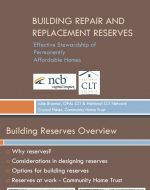The added cost and unpredictability of homeowners association (HOA) dues can affect the success of inclusionary housing policies. Many inclusionary housing programs encounter the problem of rising HOA dues, which undermine the affordability of below market-rate (BMR) homes. Particularly in high-priced markets, HOA dues can form a significant portion of the home cost for low-income residents. While there are a number of best practices that help protect affordable homeowners, there are no perfect solutions. This document lists best practices from which to create a successful HOA policy. View Document
One of the most significant administrative challenges for many programs is ensuring that units are in good condition when they are sold. Many programs take steps to actively encourage homeowners to perform repairs regularly. Programs also often require condominium boards to submit annual budgets to ensure that maintenance budgets and reserve contributions are sufficient to meet likely building needs.
It is more difficult to ensure that individual homeowners perform regular maintenance. Here are a few approaches being used by communities today:
- Reserve fund fee. While physical inspections are rare, some programs, such as the Community Home Trust in Chapel Hill, North Carolina, require a reserve fund payment as part of the monthly program fee. This helps pay for the repair and replacement of certain building components.
- Designated stewardship fund. The Champlain Housing Trust in Burlington, Vermont, has a resource they fund with resale fees that offers loans to help lower-income homeowners afford necessary repairs. The same resource is sometimes used to reinvest at resale to ensure that the home is transferred in good condition to the next low-income homebuyer.
- In-lieu fee revenue. New Jersey jurisdictions draw on local housing trust funds supported by in-lieu fee payments to repair existing units.
In addition, many programs inspect units prior to sale and either require sellers to perform repairs or deduct the cost of repairs from the owner’s equity. The Stewardship Standards for Homeownership Programs published by Grounded Solutions Network includes standards to maintain written criteria about the condition of the home at resale. It identifies who is responsible to make repairs prior to resale and outline the process for inspecting homes prior to transfer to ensure required repairs are complete.
It is important to note that the need for repairs does not result in a lower price to the buyer, but the price remains the same and the work is done to repair the home where necessary. This will work for most sales, but in cases of serious deferred maintenance, more significant renovation may be necessary.
Burlington, Vermont
Like many community land trusts, the Champlain Housing Trust in Burlington sometimes purchases units and renovates them before reselling them to new buyers. CHT considers this kind of renovation a normal part of the lifecycle of inclusionary homeownership units. In addition to charging sellers for damage and deferred maintenance, CHT sets aside up to 3 percent of the sale price of each land trust home in a stewardship fund which allows them to help pay for upgrades when necessary.
Capital Improvement Credits
Some resale formulas include provisions to allow homeowners to add capital improvements to the price. While this tends to be an effort to reward homeowners for installing certain improvements, it can also be designed to help compensate owners who have had to invest heavily in some capital system replacement during their tenure as homeowners.
Resources

Repair and Replacement Reserves for Homeownership: A How-To Guide
The deferred maintenance of resale-restricted homes can significantly undermine the success of the program. Community Land Trusts, leaders in the long-term stewardship of resale-restricted housing industry, have started implementing repair and replacement reserves as part of their stewardship program in order to better ensure the long-term viability of the homes themselves. This guide outlines various options for funding and implementing such a strategy. View Guide


